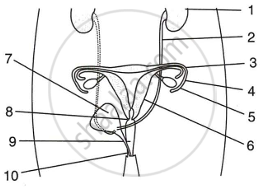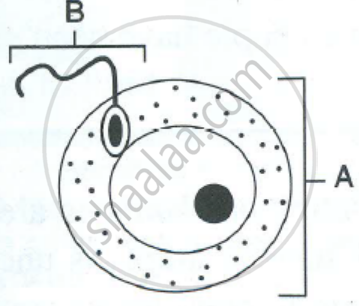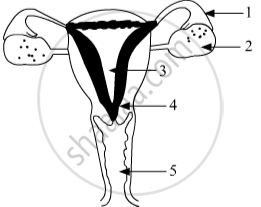Advertisements
Advertisements
प्रश्न
Find the odd one out and write it: vagina, uterus, vas deferens, ovary
उत्तर
Vas deferens.
It is a part of the male reproductive system, while the vagina, uterus and ovary are parts of the female reproductive system.
APPEARS IN
संबंधित प्रश्न
Explain the process of fertilization in human beings.
Describe, in brief, the changes the uterus undergoes
(i) to receive the zygote.
(ii) if zygote is not formed
List two example of each diseases caused due to (i) bacterial infection and (ii) viral infection. Which device or devices may be used to prevent the spread of such diseases.
Describe in brief what happens to the zygote after it gets implanted.
Write the site of fertilization and the part where the zygote gets implanted in the human female.
What could be the reasons for adopting contraceptive methods?
State the changes that take place in the uterus when Implantation of embryo has occurred
Given below are diagrams showing the different stages in the process of fertilisation of an egg. in the human female reproductive tract.
Study the diagrams and answer the questions:
1) Arrange the letters given below each diagram in a logical sequence to show the correct order in the process of fertilisation.
2) Where does fertilisation normally take place? and What is ‘Implantation’ that follows fertilisation?
3) Mention the chromosome number of the egg and zygote in humans.
4) Explain the term ‘Gestation’. How long does Gestation last in humans?
5) Draw a neat, labelled diagram of a mature human sperm.
Where is the male gamete formed in humans?
Which part of the human body produces sperms?
What do the testes in a man produce?
What are the male and female gonads in human beings? Mention their functions.
fertilisation in humans can occur only once in a month. Why?
What is the scientific name of womb?
What is the role of seminal vesicles and prostrate gland in human male reproductive system?
In human females, an event that indicates the onset of reproductive phase is :
(a) growth of body
(b) change in hair pattern
(c) change in voice
(d) menstruation
The normal body cell of an organism contains 28 pairs of chromosomes. The number of chromosomes present in its germ cell will be
(a) 28
(b) 14
(c) 56
(d) 42
When a fertilised egg E formed in the oviduct of a human female divides repeatedly to form an embryo, the embryo gets implanted in the thick and soft lining of the uterus. After this a disc-like special tissue T develops between the uterus wall and embryo through which all the requirements of the developing embryo (and foetus) are met from the mother's body, The embryo is connected to the tissue T through a string like structure S.
(a) What is the other name of fertilised egg cell E?
(b) What is the name of tissue T?
(c) Name the string-like structure S.
(d) Name two substances which pass from mother's blood to embryo through tissue T and, one type of substance which passes from embryo to mother's blood.
(e) What happens to S when the baby is born? Why?
Given below is a diagram of two systems together in the human body.
 |
- Name the systems.
- Name the parts numbered 1-10.
- Describe the functions of the parts 3, 4, 5 & 6.
- What will happen if the part 3 on both sides gets blocked?
The diagram below represents two reproductive cells A and B. Study the same and then answer the questions that follow:
 |
- Identify the reproductive cells A and B.
- Name the specific part of the reproductive system where the above cells are produced.
- Where in the female reproductive system do these cells unite?
- Name the main hormones secreted by the (1) ovary (2) testes.
- Name an accessory gland found in the male reproductive system and state the function of its secretion.
Write two examples of sexually transmitted diseases caused by bacteri.
State the role of placenta in the development of embryo.
List and explain in brief three methods of contraception.
In male and female reproductive system of human, ______ gland is same.
Give the name:
Methods of family planning.
Gender of child is determined by the male partner of couple. Explain with reasons whether this statement is true or false.
Draw a diagram to display the vertical view of human female reproductive system and label the following parts in the diagram:
(1) Ureter
(2) Ovary
(3) Funnel of fallopian tube
(4) Urethra.
Define the following:
Parthenogenesis
Define the following:
Clone
Define the following:
Implantation
Identify the given diagram.
Name the parts 1 to 5. 
What are the signs of puberty in human males and females?
Differentiate on the basis of what is indicated in brackets :
The prostate gland and Cowper’s gland (the nature of secretion)
Choose the Odd One Out:
Choose the Odd One Out:
The male homologue of the female clitoris is ____________.
Which one of the following statements about human sperm is correct?
Match Columns I and II and select the correct option.
| Columns I | Columns II | ||
| i. | Transfer of sperms in the female genital tract. | a. | Gestation |
| ii. | Delivery of baby | b. | Fertilization |
| iii. | Fusion of male and female gamete. | c. | Parturition |
| iv. | Formation of sperms and ovum | d. | Insemination |
| e. | Gametogenesis |
A zygote is formed by the fusion of a male gamete and a female gamete. The number of chromosomes in the zygote of a human is ______.
